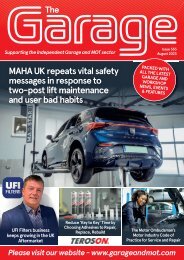You also want an ePaper? Increase the reach of your titles
YUMPU automatically turns print PDFs into web optimized ePapers that Google loves.
INDUSTRYNEWS<br />
Industry insight<br />
MOTs<br />
IN THE POST-PANDEMIC ERA<br />
Bill Fennell, <strong>The</strong> Motor Ombudsman’s<br />
Chief Ombudsman and Managing Director,<br />
looks at some of the key factors affecting MOTs<br />
in the post-pandemic era.<br />
MOTs have been a staple source of revenue and footfall for garages<br />
and workshops since the 1960s. However, with the recent decline in<br />
new car registrations and changes brought about by the pandemic,<br />
this is all having an underlying impact on the short and longer-term<br />
trajectory for MOT demand.<br />
Some of the key factors influencing the testing sphere for the<br />
remainder of 2022 and beyond, are as follows:<br />
New car registrations have fallen by around<br />
two million since 2019<br />
<strong>The</strong> pandemic and ensuing parts shortages have led to a decline in<br />
annual UK new car registrations. In 2019, it was 2.3 million, in 2020<br />
this dropped to 1.63 million, and to 1.64 million in 2021. <strong>The</strong> latest<br />
figures for August 2022 year-to-date show a similar picture in that<br />
new car registrations in the UK are 35% down on 2019 at about<br />
983,000, and are forecast to end the year once again at around<br />
1.6 million. <strong>The</strong> result of this is a combined drop of circa 2.1 million<br />
registrations over a three-year period relative to the annual figure<br />
seen in 2019 and before.<br />
<strong>The</strong> effect of this is that, between 2023 and 2025, MOT stations<br />
will see a corresponding fall in throughput in three to six-year-old<br />
vehicles requiring their test. On the assumption of a maximum<br />
chargeable figure of £54.85 per test, this equates to potential lost<br />
revenue of around £115 million for businesses nationwide, which is<br />
not an insignificant sum.<br />
Recent industry estimates point to a slight increase in new car<br />
registrations to nearly 1.9 million for 2023, as the automotive sector<br />
continues to grapple with the strain of the cost of living crisis and<br />
ongoing semiconductor chip issues. On a positive note however,<br />
this means that footfall at MOT stations could start making a small<br />
recovery in 2026.<br />
Electric vehicle (EV) ownership is increasing<br />
As with hybrids, pure electric vehicles (EVs) have witnessed a<br />
notable growth in popularity in recent years. For example, in 2019,<br />
37,850 new pure battery electric vehicles took to UK roads, a 144%<br />
increase on the year before. This has since jumped to 108,205 in<br />
2020 and to 190,727 units in 2021, with close to 137,500 already<br />
registered in the first eight months of 2022. This means that,<br />
EVs from the “class of 2019” will require their first MOT this year,<br />
although in small numbers. From 2023 onwards however, a larger<br />
proportion of battery-powered cars will require an MOT, and we<br />
expect this trend to continue going forward.<br />
Staying on the subject of EV MOTs, it has been interesting to<br />
read that, following a recent analysis of 50 million Driver and<br />
Vehicle Standards Agency (DVSA) testing records for the period<br />
2019 to 2021 by two separate organisations, the jury remains out<br />
as to whether EVs are in fact, more or less likely to fail their first<br />
MOT compared to petrol, hybrid or diesel models. One school of<br />
thought is that, because EVs are subject to fewer checks than their<br />
internal combustion engine (ICE)-propelled counterparts – due to<br />
the absence of emissions and other components, such as catalytic<br />
6 THE GARAGE<br />
6, 7 Industry Insight TMO.indd 1 15/09/2022 11:45


















